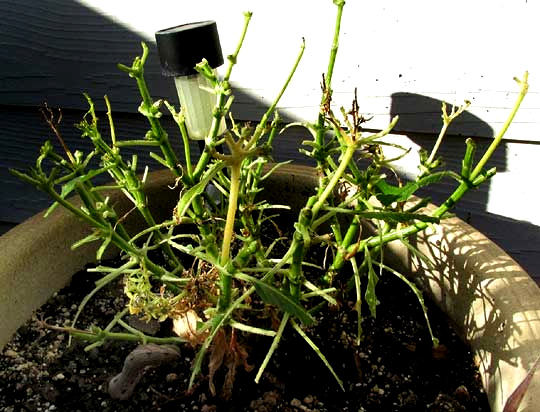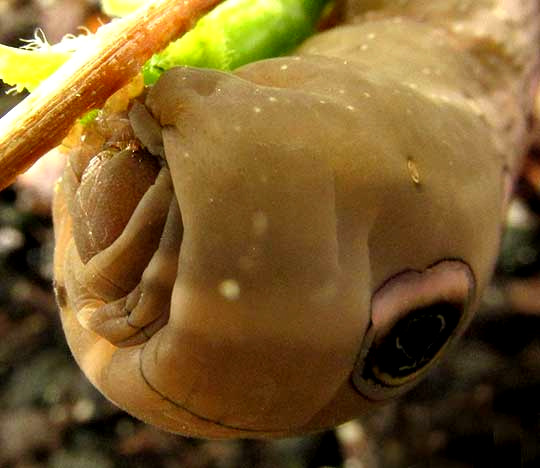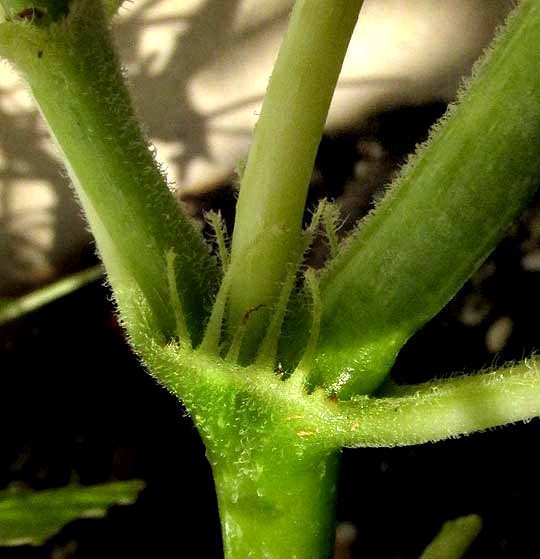Excerpts from Jim Conrad's
Naturalist Newsletter

from the September 7, 2014 Newsletter issued from the Frio Canyon Nature Education Center in the valley of the Dry Frio River in northern Uvalde County, southwestern Texas, on the southern border of the Edwards Plateau; elevation ~1750m (~5750 ft); N29.62°, W99.86°; USA
TERSA SPHINX HORNWORM
At daybreak each morning my neighbor Phred steps from his house and waters a long row of potted plants along his house's sunny side. Earlier this week one of his favorite plantings turned up as nothing but a pitiful cluster of nibbled-on stems, as you can see below.

In that picture, if you look closely, down in the lower, left corner there's a finger-thick, brown, juicy-looking hornworm hanging beneath a ravaged stem, and that's one of the culprits. A similar caterpillar was on the ground beneath the plant. At the top of this page a close-up of the caterpillar shows a handsome eyed pattern along its sides, a curious "square-scaled" design on the skin, and a "horn" at the end.
Both caterpillars kept their heads safely tucked beneath folds of skin at their enlarged front ends, as shown below:

That picture also shows the big "eye" on the swollen front end, and of course this enlarged front with two big "eyes" might dissuade a potential predator from taking a stab at our little plant eater.
Normally I wouldn't even attempt to identify such a caterpillar because volunteer identifier Bea in Canada is much better at it than I, but this time I noticed something that might give me an advantage in the ID process. It's shown below:

That's a stem node on the plant the caterpillars had devoured. At this node two leaf petioles come together, so the plant's leave are "opposite," and above the two leaves are three stems, displaying a certain kind of stem branching not found among all plants. The most distinctive features, however, are the comb-like, upward projecting "teeth" arising from the flange-like item connecting the two leaf petioles, one comb on each side of the stem.
These are stipules. Some plants have them and others don't. Most stipules are like tiny leaves arising at the bases of leaf petioles, and they come in many shapes and sizes. Often they fall off the leaf once the leaf expands to full size, but not always. Stipules provide protection to leaves during their bud stage and shortly thereafter.
When you see such stipules connecting opposite leaves, you should think "Rubiaceae," sometimes called the Madder Family. It's a big family, but mostly tropical. Coffee plants and gardenias belong to it. However, the family is poorly represented in the Temperate Zone, so I figured that simply by doing an image search on the key words "caterpillar Rubiaceae" I might see a picture of our caterpillar.
And, I did. Our hornworm is the larval stage of the Tersa Sphinx moth, XYLOPHANES TERSA, a mostly tropical American month distributed from Argentina and Brazil north through northern South America, Central America, Mexico, the Caribbean area, and in the US from Massachusetts south to south Florida; west to Nebraska, New Mexico, and southern Arizona. Bea in Ontario came up with the same ID using her own approach.
The ButterfliesAndMoths.Org website states that this moth's caterpillars feed on "Smooth buttonplant (Spermacoce glabra), starclusters (Pentas species), Borreria, Catalpa, and Manettia species." All these plants are members of the Rubiaceae, except Catalpa.
The Tersa Sphinx moths these hornworms eventually will produce are large and brown -- with wingspans of about 2¾ inches (60-80mm). They begin feeding on flower nectar at dusk.